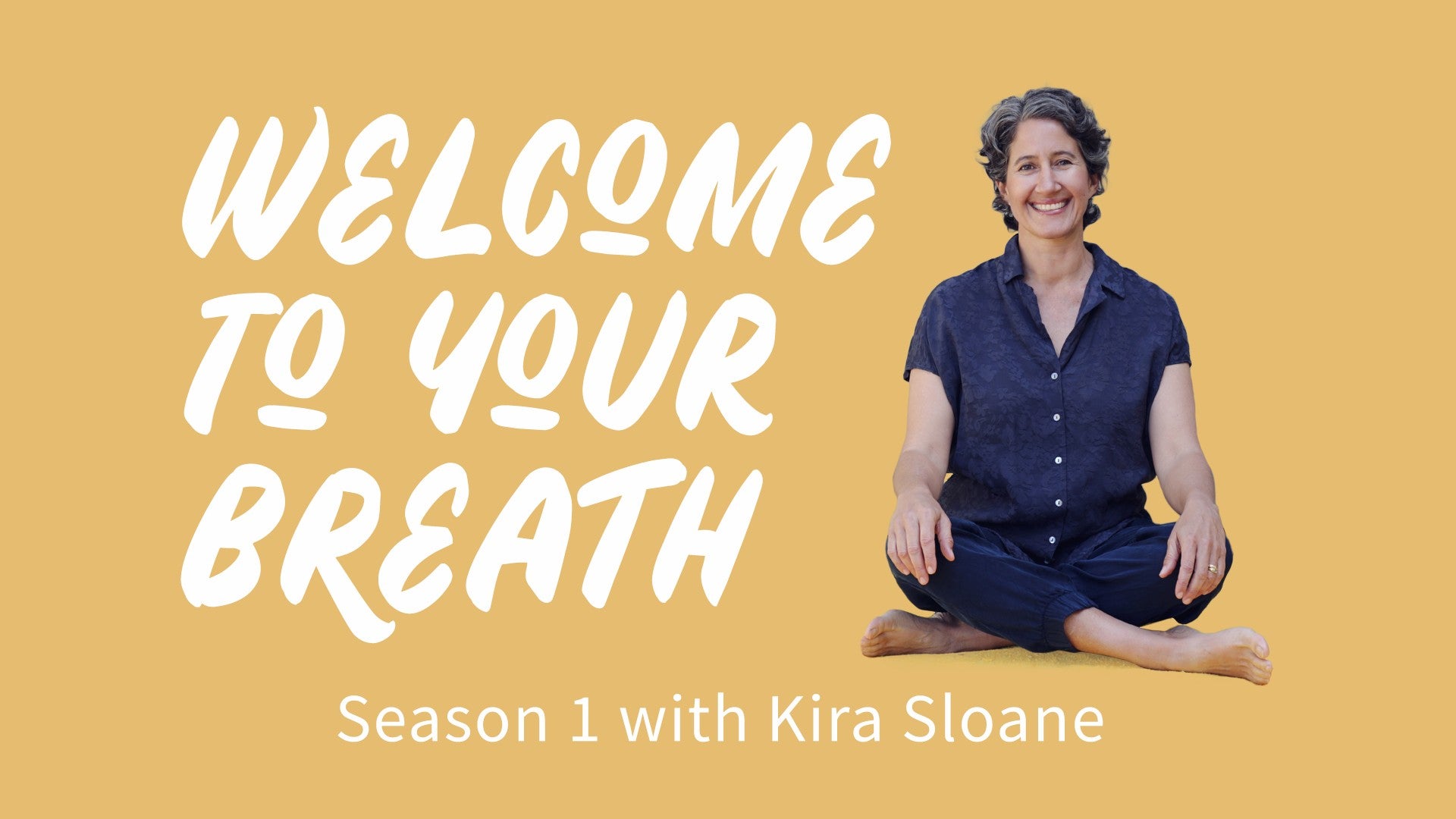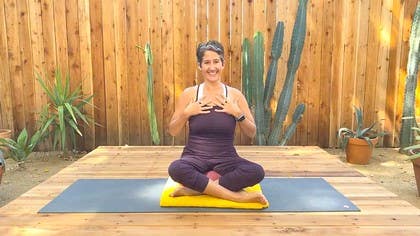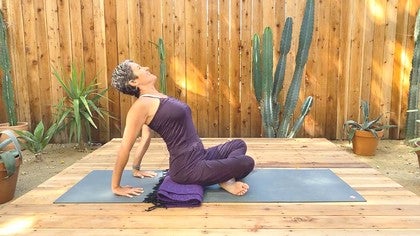Description
About This Video
Transcript
Read Full Transcript
So what inspires the breath? This next episode could be done lying down or seated. It's a bit of an exploration contemplation meditation as we gloss through the miracle of these mechanisms with the purpose of being awed and grateful. So the main purpose of the inhale in the body is to encourage the exhale because more important to the biology survival than the right amount of oxygen is to release the buildup of carbon dioxide. It is the buildup of carbon dioxide that is more detrimental for us than a lack of oxygen. So how this works, just bring your hands up to kind of that occiput region of your skull. You can kind of feel that occiput, the base of your skull, right around that region. Just bring your hands here. So right about here in the lower half of your brainstem sits what is known as the medulla oblongata. And right in the medulla oblongata sit these little pods known as chemo receptors and these little pods are sensing the pH of your blood. And when these little pods sense that there's too much carbon dioxide, when they're like, oh, that's too much, right? They send a signal to the phrenic nerve. Now the phrenic nerve emanates from the C3 to the C5, C for cervical. So right around the same region, this phrenic nerve originates about here and then it runs down along the sides of your trachea and innervates your diaphragm. So this nerve innervates your diaphragm. Okay. The diaphragm, which we've explored in earlier episodes, right? This beautiful bowl shaped muscle that attaches up to this fifth rib and sits like a dome right underneath the lungs, right? As this phrenic nerve innervates the diaphragm, it encourages the inhale. So like we've been doing in earlier episodes, bring your hands around that diaphragm. Maybe your anatomy lets you hold your hands like this, or maybe it feels better to hug, but hold around here and inhale. Let that diaphragm widen into your hands. And as you exhale, soften. So on the inhale, the diaphragm contracts, which creates a flattening and a widening of the ribs, which allows the lungs to expand. Just like spend a few moments here, like understand this. And energetically then, excuse me, not energetically, but anatomically, right? As you have this inspiration, as the body has generated this opening, what's going to follow is the exhale. And in general, and while it's more complicated than this, when we inhale, we bring in oxygen. And when we exhale, we generally release carbon dioxide. That's a simplistic description, but we'll go with that for now. So this expansion, okay, of the rib cage, which then allows the lungs to expand, creates a vacuum, which then allows the breath to draw in, whether that's through the mouth or the nose. Okay, now, specifically, and I might've mentioned this at the beginning, I'm referencing what we're going to call the unconscious breathing patterns. So this is how the breathing works when we're not paying attention or not deliberately trying to do something different. Okay, so diaphragm contracts, lungs expand, air whooshes in through the nose or the mouth, goes down the trachea, and some of you know, this is the windpipe, which branches into the bronchi, you know, like two branches of a tree, and then fans out into the bronchioles. Whenever I speak of these, I always feel like I'm ordering some delicious Italian dish. So as it fans out into the bronchioles, of which there are a thousand. And just for a moment here, let your hands come on to the upper chest, on to where the lungs sit. And in your mind, you know, maybe you've already seen pictures of the lungs and the bronchi and the bronchioles, but maybe you've also seen a tree, particularly a tree with many, many, many, many branches moving into small little twigs. Because when you, when you have the opportunity to see the lungs in real life, it's this beautiful spongy tissue that sits on these beautiful branches. And every time you see a tree, particularly if you get to see one without the leaves, you can really see the architecture. This is what it looks like in here. And so with each inhale, right, this, this air moves down into the trachea, into the bronchi, into the bronchioles. And then at each end of the bronchioli is what you know as the avioli. These tiny, tiny, tiny little sacks. And sometimes the imagery of cauliflower is used or, you know, if you're more of a blackberry fan, like big blackberries. And each of these little tiny sacks, right, which are only one cell thin, are covered in capillaries, which allow the blood flow to move across. And this is where so much of the miracle occurs. Because these aviolis are only one cell thick. And these tiny little blood vessels of the capillaries are only one cell thick. This is where we have, they call it the basic law of diffusion. But essentially, all of this rich oxygen comes in, met with all of this blood full of carbon dioxide. And strangely enough, gases seek to move to where there is less of them. So the oxygen moves into the oxygen deficient blood, and the CO2 moves out back into the lungs. Hemoglobin is the particular protein that holds these two. And then because the nature of whatever rises, the nature is to fall, eventually the diaphragm relaxes. And because of the pressure, okay, coming back up from the lower body, the lungs naturally reduce, compress, and the air is expelled. Now we haven't even talked about how that oxygen gets to the rest of your body, because how did that blood get there? And where does it go from there? So just gently, just for the miracle of it, let your hands come back onto your lungs. So maybe you're sitting or maybe you're supine and just use your mind's eye. Like imagine the air coming in, moving to these tiny, tiny, tiny moments of exchange. Imagine the blood offering up the CO2 and receiving the oxygen, oxygen, and imagine it moving on. Can you kind of process that? And part of this, right, like part of this is to start to become more and more awake to the miracle that's happening right underneath our nose. You know, sometimes it can feel like nothing's going right. And yet when you drop into all the things that are really working, it's quite miraculous. And so keep one hand on the lungs, maybe your right hand on the lungs, but let your left hand be more attentive to where your heart sits, now your heart.
Sometimes it's referred to as a pump, which is really, it's just not as lovely as the heart really is. When you truly get to see the heart, it's this soft, tender, beautiful offering. But as the carbon dioxide rich blood comes back up to the heart, whether it's coming from the brain, okay, or up through the body, it's coming back in through the upper right chamber of the heart. It moves in through this right chamber, down into the right ventricle and whoosh, it is moved through the pulmonary arteries into the lungs, where then this miracle of exchange occurs. That oxygen rich blood then moves back into the left upper chamber, down into that left ventricle and then up into the brain or out into the body where that same beautiful miracle of exchange happens. And that oxygen rich blood offers the oxygen up to the tissues and takes back that CO2. Okay, so maybe you're supine or maybe you're seeded soft in the jaw, soft in the eyes. Let your jaw go slack. And I've given a very simplistic I've left so many details out, so many words out, so many details out, so many miracles have been left out of this explanation. But to just allow yourself for a moment to like not take for granted this miracle of the breath that's happening with or without us that happens continually, somewhat easily and generously. This miracle of the breath which we have to give very little thought to, but when we do, when we start to pay attention, we start to feel grateful and we start to even try to assist in becoming more conscious and awake. How much can occur? Thank you.
Welcome to Your Breath
Comments
You need to be a subscriber to post a comment.
Please Log In or Create an Account to start your free trial.

















